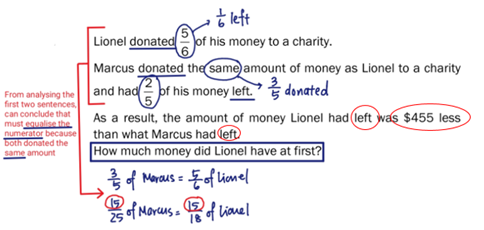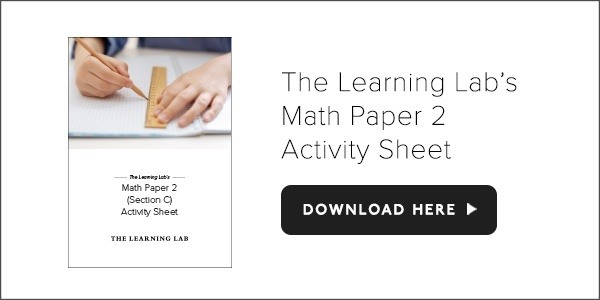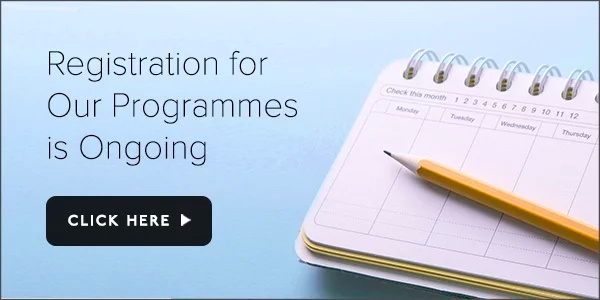
Imagine you are a student doing a Mathematics paper.
Here’s an example of one of the many question types you may be expected to solve for Paper 2 (Section C).
| Example of a Math Problem Sum Question Lionel donated 5/6 of his money to a charity. Marcus donated the same amount of money as Lionel to a charity and had 2/5 of his money left. As a result, the amount of money Lionel had left was $455 less than what Marcus had left. How much money did Lionel have at first? |
Now, imagine tackling the problem sum above after spending an hour working on 10 other problem sums — how would you feel?
For most students, Section C of the Math Paper 2 is the most challenging. Students often feel overwhelmed because problem sum questions:
appear unbelievably long
contain many words and numbers
require more time and critical thinking to solve
In this article, Lee Ying, Math Subject Head for The Learning Lab Marine Parade, shares 5 critical exam skills that will improve your child’s approach towards Math problem sums.
Do note that Lee Ying will be using the same above Math question to illustrate how your child should apply the different skills.
1. Question Analysis
A problem sum seems intimidating at first glance because of the sheer volume of information that the question appears to have.
For some students, seeing two fractions in one long question creates an impression that the question is difficult to solve. Coupled with the pressure of time, students then tend to skip the question to attempt other seemingly simpler questions first.
To overcome this challenge, our teachers inculcate a habit in our student to read every Math question twice.
This will help your child to break down the questions into smaller parts while reading, which allows them to retrieve and process relevant and critical information.
For some learners, it helps if they use their imagination and picture the scenario in their minds.
During the first reading,
read the question once through without writing any notes
box up the question statement

During the second reading,
read the question sentence by sentence
make notes on the question itself and spot identifiers
After the second reading, your child will be able to recognise that in this particular question:
there are two parties (Lionel and Marcus) involved
two scenarios (donated vs left) exist
Here, we would encourage your child to make notes on the question by noting the keywords and writing down additional inferred information.
2. Concept Identification
The key identifier in this question is “donated the same amount of money”. This means that your child will have to equate the numerators.

If your child is unable to identify the concept immediately, making links to the topic (in this case, Fractions) will help him or her to recall better. Drawing a model may also help him or her to better visualise the question.
3. Execute the Steps to Solve the Question
Tip 1: Label each step clearly.
Every step and every number has a meaning.
It is important for your child to be clear on what each step is referring to. That is why clear labels are essential to ensure that the information (from the question) does not get jumbled up in his or her mind.
Some students tend to do all the working in their heads and then the information gets muddled up, leading to unnecessary errors.
Tip 2: Make sure that all information is accounted for.
Sometimes, information that is unnecessary is given in the question (some topics more than others). It is important to recognise that and strike off that number.
Tip 3: Check your answer.
At the last step, read the question statement again and make sure the solution answers the question.
4. Check Answers Thoroughly
Often, students move on to other questions right after they have written their final answer.
However, it is important for your child to check his or her answers again to avoid making careless mistakes. This is the most important step, yet it is often overlooked or done ineffectively.
| Wrong Way of Checking Answers | Better Way of Checking Answers |
| One ineffective way of checking is doing the question again with the same steps. Doing the same question twice in the exact same way will not help your child to identify any errors as he or she will arrive at the same answer.
|
Use the final answer you have gotten from the first try and plug it back into the question. Please refer to example below, based on the final answer being $1170. |
This checking method can easily done, especially with a calculator at the Primary 5 and Primary 6 levels, and requires the student to write down the numbers that are calculated.
For the example in this article, we can check if the final answer is correct with the following steps.
| Step 1: 5/6 x $1170 = $975 (write down 975 above “Lionel donated”) Step 2: 1/6 x $1170 = $195 (write down 195 beside previous note of “ left”) Step 3: Since Marcus “donated the same amount”, write down $975. This means 3/5 of Marcus is $975. Step 4: To find 2/5 of Marcus, take $975 ÷ 3 x 2 = $650 Step 5: Since Lionel has $195 left and Marcus has $650, check the difference $650 - $195 = $455 Since 455 is found in the question, the final answer of $1170 is correct. |
This method of checking — by plugging the final answer back into the question, helps your child to be more confident to tackle the rest of the paper.
Remember that checking of answers is a good working habit that needs to be instilled even for your child's daily work in other subjects.
5. Time Management
Time management is an essential part of doing the examination paper. When students are working under time pressure, they must also keep their emotions in check as anxiety will affect their ability to recall concepts and methods.
For this, I recommend that your child:
Engage in Timed Trials
Based on my experience, students should spend no more than 1 minute per mark of a question. For example, a 2-mark question requires a maximum time of 2 minutes.
A student who is prone to careless mistakes and does his or her paper really quickly is probably not checking effectively or not checking at all.
If your child falls under this category, he or she can practise timing himself or herself when attempting Math questions at home.
More importantly, your child should only be allowed to attempt the next question when the allocated time for the current question is up. This last step is effective in helping your child to develop the good habit of checking his or her final answer.
Reflect after Timed Trials
Ideally, all students should approach every question with a refreshed mind and an “I can do it!” attitude.
Unfortunately, there will always be residual emotions from tackling a difficult question; your child may feel frustrated, disappointed and/or sad.
First, it is important for your child to acknowledge that it is natural to feel negative emotions during the course of doing a paper. More importantly, your child should be thinking of different ways to overcome the challenge.
Some of these techniques include:
i. Stress management techniques such as breathing and stretching to calm your child down when he or she feels pressured.
ii. Skipping a difficult question for the time being — it is important for your child to understand that it is all right to move on to the other questions first before returning to the difficult question.
To help your child practice the above exam skills, we have put together a Math Paper 2 (Section C) activity sheet for your child. This practice will come in handy as your child prepares for an upcoming Math exam
Click here or the link below to download and try out these exercises.
Give Your Child the Opportunity to Conquer Math in the Right Ways
From concept maps, topical notes and revision handouts, your child will gain a thorough understanding of each topic. In addition, quizzes, tests and tutorials help to reinforce learning, by allowing your child to practise and refine the application of Math knowledge and skills.
Find out more about our Maths programmes here.
The Learning Lab is now at locations. Find a location that suits your needs.
If you have any questions about our range of programmes or class schedules, you may contact us at 6733 8711 or drop us an email at enquiry@thelearninglab.com.sg.


